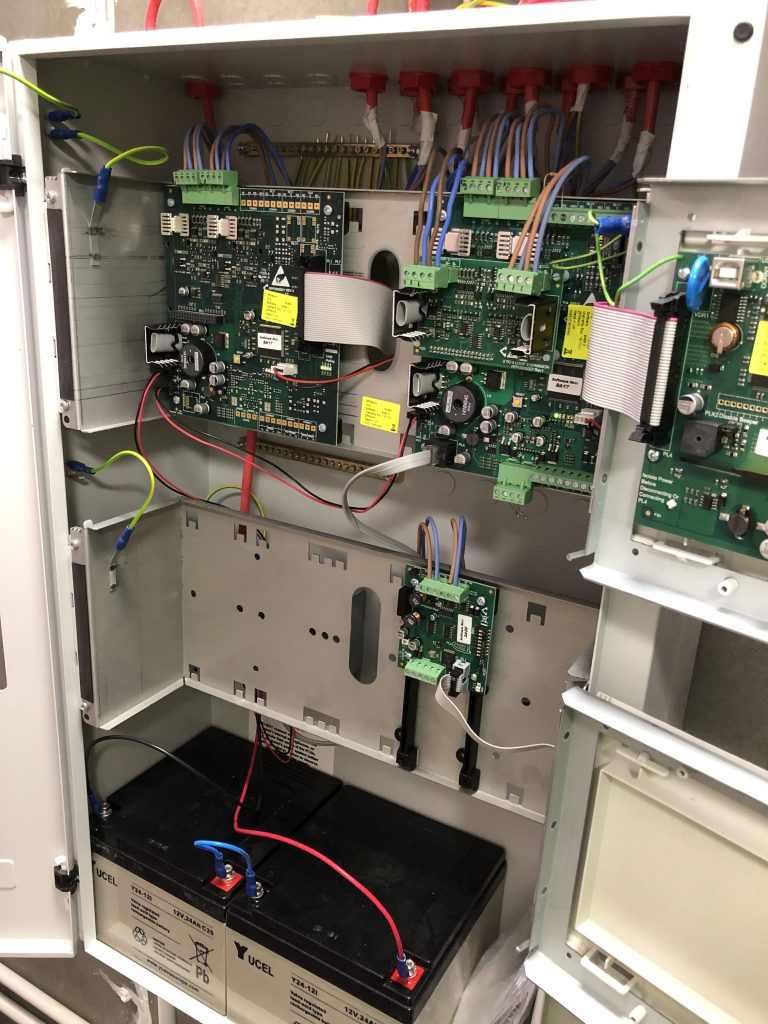Fire Alarms
For Commercial Properties
Blaby Alarms offer quality installations for Fire Alarms to British Standard of BS5839 part 1 & part 6 across Leicestershire and the Midlands, for all types of commercial premises including:
- Student accommodation
- warehouses and distribution centres
- shops and retail complexes
- Hotels
- Schools and Universities
- Offices
- leisure facilities
- business units
- healthcare facilities
When you choose Blaby Alarms for your fire alarm installation or upgrade you will receive a complete design and installation service to BS5839 part 1 and part 6.
Our expert teams install L1, L2, L3, L4, L5, LD1, LD2, LD3, P1, P2 and M fire alarm systems with NIC EIC certification on completion.
All our fire alarm systems include:
- Audible warning
- Control panel
- Zone wiring
- Smoke detectors
- Break glass call points and heat detectors as required.
Our engineers will ensure your specification fully meets your requirements. This can be checked for Fire Officer approval if required.
Related Services
FAQs
How can I stop wasting money through false fire alarms?
Does your business Fire Alarm keep having false alarms? If so, have you ever calculated just how much this costs every time it happens?
- Cost of every member of staff losing half an hour’s work
- Orders lost with phone calls unanswered
- Machines running empty for half an hour
- Cost of maintenance team trying to find the fault
- Call out fee to an Alarm specialist to reset the controls
- Cost of supply and fit for new parts or maintenance to the system.
- An Invoice from the Fire Service for attending an automatic call out
Fire Service Cause for Concern
The overall costs of every false fire alarm does have an impact on the UK economy. Frequent false alarm incidents are a major cause for concern for the Fire Service and the total cost of each incident is estimated at around £4,016 per business.
Reputable Alarm Installation
If your alarm was installed by a reputable company, this really shouldn’t occur any more than once a year, and having a basic alarm service contract should cover the costs to resolve one or two false alarms per year.
Lack of Maintenance
Every business comply with the regulations must have a proper maintenance contract for their alarm, – which will cost from £135, depending on the size of the property and the complexity of the system.
The loss of earnings to resolve just one false alarm will cost the business around 30 – 40 times more than paying for an annual service and maintenance contract, so outweighing any savings you are trying to make by saving this cost.
It is also a business expense, and will help to reduce the company tax bill.
Do landlords need LD1, LD2 or LD3 fire alarms?
Landlords know that rental domestic properties must have working Fire Alarms fitted, but do you know which grade of alarm needs to be fitted where?
You may have fitted an alarm on every storey of your property, but was it the right grade? If not, you could be leaving yourself open to prosecution if anything went wrong.
Here is a quick guide to the LD1, LD2 and LD3 alarms, where to install them, and what the differences are between the grades. LD3 gives you the lowest grade, or minimum protection and LD1 provides the maximum protection. Here are the details:
Minimum level of protection = LD3 Fire Alarm Coverage
- Detectors should be installed on the escape route of every storey,
- must be placed WITHIN 3 METRES of ALL BEDROOM DOORS
- and if the hallway is longer than 7.5 metres, you need to install MORE THAN ONE Alarm. (1 every 7.5m)
- Never install in a toilet, shower or bathroom.
Additional Protection = LD2 Fire Alarm Coverage
- This is in addition to the requirements of LD3.
- Smoke or heat alarms should be fitted in all rooms or areas that present a high risk to occupants.
- Smoke alarms must be fitted are on each storey within every 7.5m of hallways and escape routes and within every 3m of all bedroom doors (apart from toilets and bathrooms).
- Heat Alarms should be located in each kitchen and installed within 5.3 metres of potential fire sources.
- Smoke or Heat alarms should be located in each living room or whichever room is most frequently used during the daytime.
Maximum Protection = LD1 Fire Alarm Coverage
- Smoke alarms are located in all hallways, stairways and circulation areas that form part of the escape routes from the house.
- Smoke or heat alarms are in all rooms or areas that present a high risk to occupants and also should be placed in all other rooms.
- Smoke alarms are on each storey within every 7.5m of hallways and escape routes and within every 3m of all bedroom doors (apart from toilets and bathrooms).
- Heat Alarms are located in each kitchen and garage and must be installed within 5.3 metres of any potential fire source.
- Smoke or Heat alarms are also located in the most frequent room used during the daytime.
The guidance appears to overlap in places, and could be misleading, so if you would like some advice on whether or not your properties comply with the Law and fulfil the guidance, then do give us a call, one of our trained Alarm specialists will be able to advise you.










